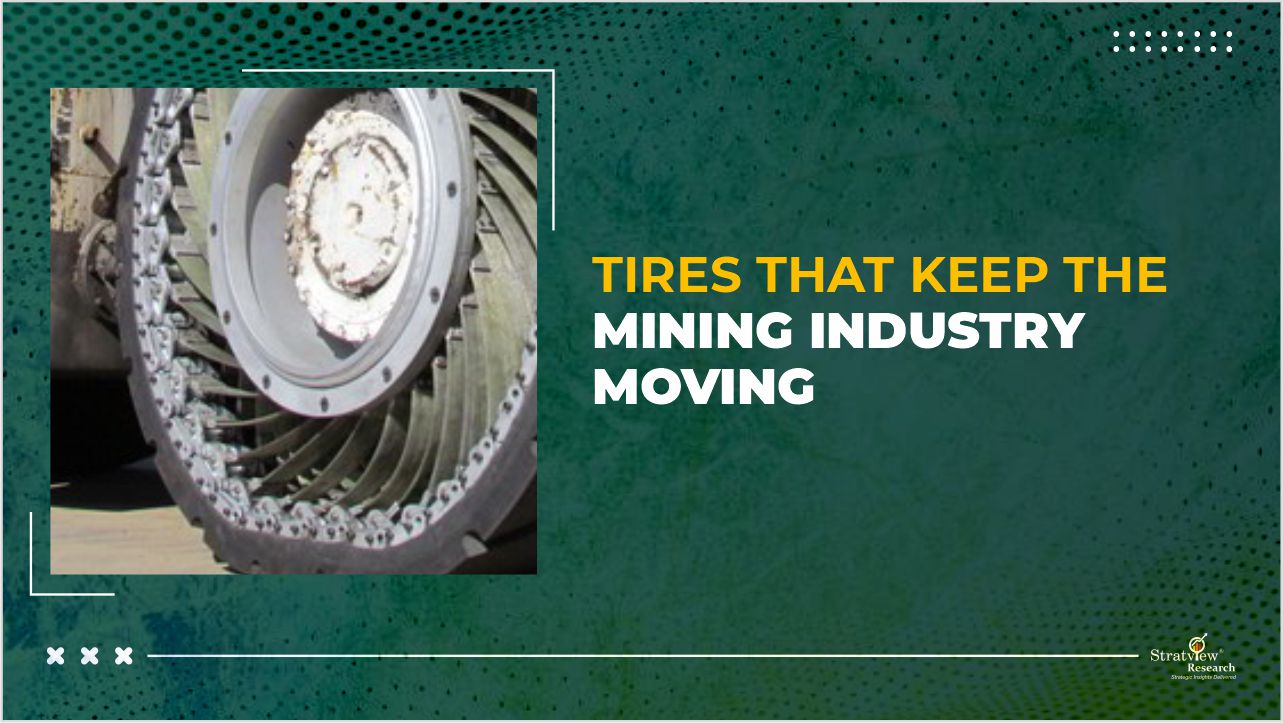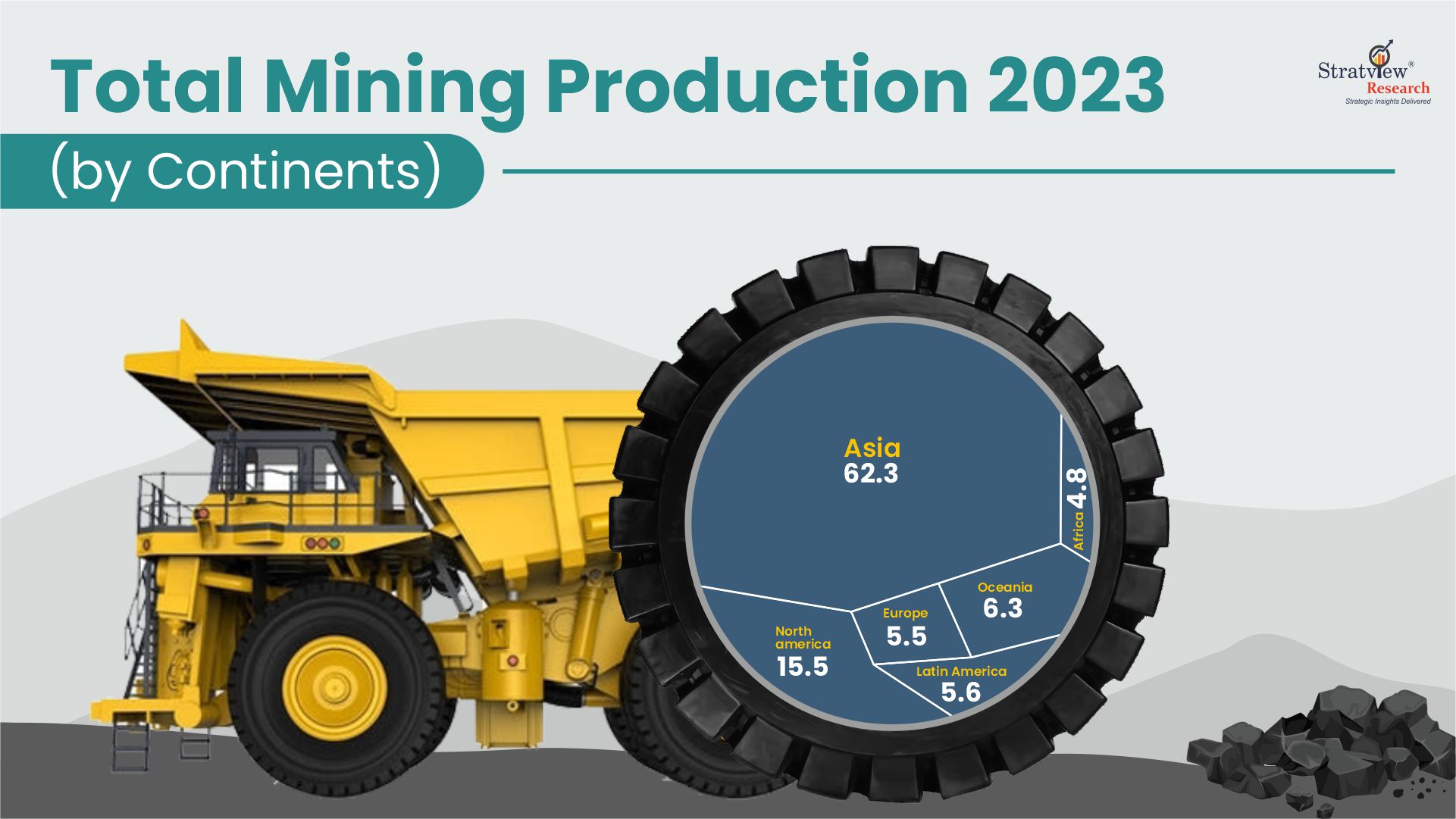
According to Stratview Research’s report on the global mining tires also indicates that surface mining accounts for nearly 70% of the global demand for mining tires. However, underground mining is also experiencing growth, due to increasing demand for minerals and metals. Underground vehicles usually include drilling rigs, scalers, bolters, loader scoops, shuttle cars, etc.
Can you imagine a tire twice your height and weighing more than four passenger cars?
In the mining industry, that’s not an exaggeration. That is just a specification of ultra-class haul trucks operating in mines. We are talking about the world’s largest off-the-road (OTR) tires having 63-inch thickness, 14 feet height and weight over 12,500 pounds. These massive components are manufactured to bear extreme loads, rough terrain, and relentless operating cycles in mining sector.
However, not just giant, but all mining tires, irrespective of their sizes and types, are meant to enable efficient operations of different mining vehicles. As mining activities and fleet expands, tire performance, selection, and maintenance are becoming decisive operational levers across both OEM and aftermarket landscapes.
Choosing the Right Tire for the Terrain
Surface mining is predominant source for extracting most of the world’s annual mineral production, and depends heavily on graders, haul trucks and loaders. Reflecting their operational scale, Stratview Research’s report on the global mining tires also indicates that surface mining accounts for nearly 70% of the global demand for mining tires. However, underground mining is also experiencing growth, due to increasing demand for minerals and metals. Underground vehicles usually include drilling rigs, scalers, bolters, loader scoops, shuttle cars, etc.
Regardless of the mining location and vehicle, bias-ply tires and radial tires are two primary tire types that are typically used in mining operations. The difference between both is more than just structural. Bias tires are cost-efficient than radial tires. Bias-ply tires have long been in the mining industry owing to their thicker sidewalls, higher resistance to cuts and tears, cost-effectiveness, etc. And these characteristics are what needed for rugged and unpaved terrains where haul trucks, loaders etc. undergo repeated loading-unloading cycles. With their superior qualities, bias-ply tires remain the industry’s preferred choice, comprising >60% of total mining tire deployments across the globe.
Radial tires are considered fuel efficient, and offer good heat dissipation, making them favorable for high-mileage or high-speed segments only.
Mining Tire Demand is Largely an Aftermarket Story
Industry data shows that by the end of 2023, the active surface mining equipment fleet stood at approximately 153,277 units, and projections suggest this figure will surpass 176,500 by 2030. Naturally, this growth will fuel fresh demand for tires from OEMs. But the aftermarket segment remains the real volume driver. Given the high capital cost of mining machinery, operators typically opt to replace worn-out tires rather than retire entire asset.
Over 70% of new tire demand in the mining sector is generated by the aftermarket. This is also obvious since mining vehicles are more prone to wear and tear due to uneven surfaces in the field, creating a frequent need for tire replacement.
Global Mining Hotspots Driving Tire Demand
It’s long been recognized that mining is fundamental to economic growth across multiple regions. The world's top mining regions are geographically diverse, with significant activity concentrated in nations like China, Australia, Russia, Canada, United States, India, Brazil, South Africa, Peru, and Indonesia. These nations have strategically positioned themselves as the top countries in the global mining value chain.
However, when it comes to mining tire demand generation, the Asia-Pacific (APAC) remains the undisputed leader with almost 60% of total mining tires demand. This is primarily driven by countries like China – the world’s largest mining economy, and India. In 2024, the global mining tires’ sales value reached approximately USD 4.6 billion. Of this, China alone generated ~USD 1.2 billion (almost half of the value generated by entire APAC), emerging as the largest national market. The United States ranked second, followed by India.
The dominance of APAC in mining tires market can be attributed to its abundant natural resource reserves, low-cost labor, and favorable geology. China, Australia, and India possess extensive deposits of coal, iron ore, copper, and rare earths.

Fig. 1: Total Mining Production (2023) by Continent.
Not to forget, this region is also witnessing rapid rise in industrialization, urbanization, and energy demand that further fuel the region’s mining activities. These factors collectively position APAC as the global epicenter of mining operations and mining tires.
Mining Tires in a Future-Driven Industry
High initial costs and raw material price volatility to environment constraints, etc. are a few challenges in the mining tires market. Despite these challenges, the future of mining tires is closely tied to the inevitable growth of growing mining operations worldwide.
The demand for minerals and metals are surging rapidly to serve the growing population, growing adoption of EVs, etc. As per the global critical minerals outlook 2024, published by The International Energy Agency (IEA), the demand for minerals like lithium, nickel, cobalt, copper, and rare earth metals will double and if world takes stronger climate actions to reach net-zero emissions by 2050 (NZE), the demand will grow almost 3X more than 2024 by 2030. This trajectory will inevitably intensify the demand for durable, high-performance machineries, mining vehicles and mining tires.
Technological innovations such as self-healing tires, real-time monitoring systems etc., are already reshaping how tires contribute to operational efficiency. These advancements are no longer optional add-ons, but essential tools in minimizing downtime and maximizing asset performance.
We said, ‘minimizing downtime’ because, in an industry where ‘uptime is currency,’ mining tires have evolved from just consumables to frontline productivity enablers. Take smart tires for instance. Strategies such as Active Tire Management Systems, are proving this point, as seen in the case of a leading Brazilian iron ore operation (2024) that reduced unplanned downtime by 20%, saving an estimated US$3.4 million annually. Such multi-million-dollar savings aren’t just beneficial for mines with thin profit margins but also represent a clear boost for all mining operations, regardless of the scale.
These technological, economical, and government-backed policies will not just keep pace with industry demands but will also impact the mining industry and the demand for its components such as tires. The road forward for the global mining tires market looks promising, with the market projected to grow from USD 4.6 billion in 2024 to USD 5.3 billion by 2027.
Authored by Stratview Research. Also published on – TyrePress
